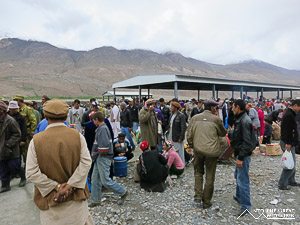Ishkashim, Tajikistan
Life in the Wakhan Valley - Part II
May 27, 2012
These times are so uncertain
There's a yearning undefined
People filled with rage
We all need a little tenderness
How can love survive in such a graceless age
- Don Henley

Besides the natural scenery and millennia of history, the Wakhan Valley is interesting today because of the juxtaposition of Tajikistan and Afghanistan. One, a nation with a war ravaged past and present, the other its neighbor, separated only by a river yet lacking many of these same problems. It’s hard to believe that the simple dividing presence of a river could make such a difference. All these differences seem to blur slightly every Saturday at the Afghan Bazaar in the border town of Ishkashim. Here the Afghan and Tajik borders open and traders and shoppers from both countries pour across the barbed wire fringed border gates to an island in the middle of the Pyanj River to a colorful weekly market.
From the Afghan side you see merchants dressed in traditional robes carrying huge sacks of goods either on their backs or on makeshift rickshaws made of lumber and old car axles. They file past the Afghan soldiers and Afghan border post to the Tajik soldiers and the Tajik border post before entering the market. Strangely enough, considering the huge problem of drug trafficking, there didn’t seem to be many searches of their bags being conducted, though this would be very impractical anyways with the large volume of goods moving back and forth.

The market was a little late getting started as early morning rain caused delays so I was able to get there early and see everything being set up. The merchants found a spot on the ground and unfurled their packages, spreading things out randomly on tarps. It was a little disappointing that there weren’t many authentic or handmade items; most of the things seemed to be straight off of the Chinese trucks that pass through the region. It was more disappointing to see that colorful Hello Kitty and Justin Bieber pattern fabrics had made their way to Afghanistan. That war has clearly been lost.

The random mix of items was not nearly as interesting as the people. There were Tajik soldiers and police, Afghan soldiers and police, Afghan merchants in robes and turbans, Tajik residents in colorful robes and shawls, well dressed Afghans and Tajiks in modern clothes, and everything in between. Walking around you could hear at least half a dozen different languages, regional dialects like Shugnani, Wakhi, Ishkashimi, along with Tajik, Dari, and Russian. While some looked unbelievably foreign in appearance, others, despite their dress and ragged clothes had facial features not too dissimilar from my own.
In this unique of a market I looked desperately for some type of souvenir that would be worth buying. Unfortunately with all the cheap Chinese items and shoes that were way too small I could find very little. I did manage to find a vendor selling Afghan Coca-Cola, probably long since expired but still unique in its own regard. I was also able to exchange some Tajik Somoni for some Afghan Afghanis, 4 Somoni netting me 40 Afghanis. Luckily I received one crisp new 10 Afghani bill as the 20 Afghani bills were so dirty and tattered that they were barely legible. Perhaps this was why the currency of choice at the market seemed to be Tajik Somoni and also US dollars for the larger items.

The market wound down around 1pm, the traders repacking their huge parcels and loading them up on their backs or their rickshaws and trudging home like many of the overburdened donkeys I had seen. I’m sure this repeats itself every Saturday but for me it was something very unique in that it afforded an opportunity to come into contact with people you only see on TV and read about in news articles. Though this border is actually open and the Afghan region across it very safe, it is just a pocket of stability, to east is the Afghan Wakhan Valley peaceful due to its sheer isolation, to west is Faizabad and Kunduz, growing areas of insurgency. It is unfortunate that the region is so unstable because it is one of the most beautiful areas I have seen and the people that inhabit it are some of the most diverse and genuine I have met. Hopefully in the future the political and ideological issues will be resolved and the region will become accessible, until then this weekly market is the best glimpse at an amazing and little appreciated part of the world.





















































